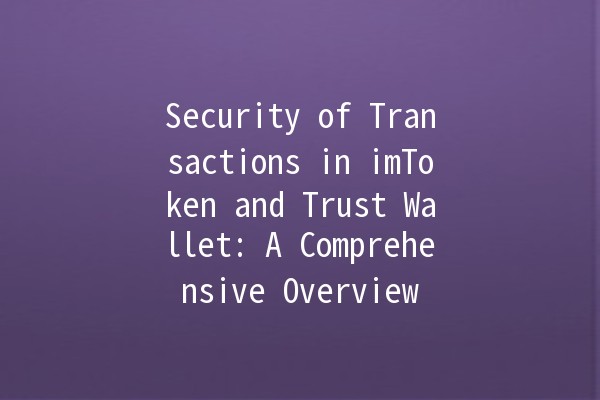In the current digital age, securing cryptocurrency transactions is paramount for users who want to protect their assets. With numerous wallets available, two prominent names stand out: imToken and Trust Wallet. This article will delve into the security features of both wallets, comparing their strengths and weaknesses, while also providing practical tips for users to enhance their transaction security.
Blockchain wallets are applications that allow users to manage their digital assets. They provide the means for users to send, receive, and store cryptocurrencies securely. However, the level of security varies significantly from one wallet to another, influenced by factors such as private key management, encryption methods, and transaction verification processes.

Cryptocurrency transactions are irreversible and can be vulnerable to various threats, including hacking, phishing, and malware attacks. As a result, selecting a wallet with robust security measures is critical for safeguarding funds. A secure wallet not only protects assets but also instills confidence in users as they navigate the everevolving crypto landscape.
ImToken is one of the leading digital wallets in Asia, designed for storing Ethereum and Ethereumbased tokens. It boasts a userfriendly interface, making it accessible for both beginners and seasoned users. imToken emphasizes security, providing features such as private key management and support for multisig transactions.
Trust Wallet is the official cryptocurrency wallet of Binance and is renowned for its high level of security and versatility. It supports a wide variety of cryptocurrencies and allows users to interact with decentralized applications (dApps) directly. Trust Wallet also offers key management facilities, ensuring user control over funds.
Both wallets store users’ private keys locally on their devices, enhancing control and security.
imToken: Uses a hierarchical deterministic (HD) wallet approach, which derives multiple private keys from a single seed. This method minimizes the need for exposing sensitive keys.
Trust Wallet: Also employs HD technology, allowing users to generate a backup seed phrase. This enables users to recover their wallets easily while keeping the private keys offline.
MFA adds an additional layer of security, requiring users to verify their identity through multiple means.
imToken: Supports password protection and biometric authentication, ensuring that only the authorized user can access the wallet.
Trust Wallet: While Trust Wallet does not support traditional MFA, it has robust encryption to safeguard user data. Users can still set up a secure passcode and utilize biometric verification.
Monitoring transactions adds another layer of security.
imToken: Users receive instant alerts for every transaction, allowing them to address any suspicious activities promptly.
Trust Wallet: Provides transaction history and realtime notifications about transactions, helping users stay informed and reactive against unauthorized access.
The ability to recover funds after losing access to a wallet is crucial.
imToken: Offers efficient backup processes through seed phrases and wallet export options, making recovery straightforward.
Trust Wallet: It also provides recovery options using a seed phrase, ensuring users can restore their wallets on any compatible device.
Both platforms maintain a commitment to security through regular updates.
imToken: Actively works on enhancing wallet security and conducts regular audits to find potential flaws.
Trust Wallet: Being a part of Binance, Trust Wallet benefits from the larger security infrastructure and regular assessments, providing users with peace of mind.
Following are some practical techniques users can adopt in conjunction with their chosen wallet to bolster transaction security:
Using biometric features such as fingerprint or face recognition significantly enhances wallet security. This method is more secure than traditional passwords.
Example Application: Users can set up biometric login for imToken and Trust Wallet, ensuring that only they can access their funds.
Keeping the wallet app and the device’s operating system up to date is critical for security patches and new features.
Example Application: Users should enable automatic updates for both imToken and Trust Wallet to benefit from improved security measures promptly.
Transacting over public networks exposes users to potential cyber threats. Always use a secure internet connection.
Example Application: If on the go, users should opt for a mobile data connection rather than public WiFi when accessing their wallets.
Even minor typos in wallet addresses can result in lost funds. Always verify addresses before sending cryptocurrency.
Example Application: Users can copy and paste addresses directly within the wallet and rely on QR code scanning to eliminate the risk of errors.
Securely storing recovery phrases is vital. A lost or compromised recovery phrase means a total loss of access to cryptocurrencies.
Example Application: Users should write down recovery phrases and store them in secure, fireproof locations, avoiding digital storage methods that can be hacked.
When deciding between imToken and Trust Wallet, users should weigh the varying security features against their specific needs. Both wallets prioritize security to ensure users can safely conduct transactions. Opting for strong security practices not only secures assets but also fosters confidence in navigating the cryptocurrency world.
Both wallets provide robust security measures, including local private key storage and encryption. However, Trust Wallet is often considered slightly more secure due to its backing from Binance and the continuous investment into its security infrastructure.
Once a recovery phrase is generated, it cannot be changed. However, users can create a new wallet to generate a fresh recovery phrase if necessary.
If you lose your phone, recovery is easy as long as you have your recovery phrase written down. Using this phrase, you can recover your wallet on a new device.
Yes, transactions made through imToken and Trust Wallet are recorded on the blockchain. However, wallet addresses are pseudonymous, providing a degree of privacy.
Both wallets offer the necessary security features for longterm storage. However, for larger amounts of cryptocurrencies, consider a hardware wallet for added security.
Yes, both wallets require transaction fees, which are determined by the respective blockchain networks. Users should always be aware of network congestion that may increase fees.
By considering the security features and implementing these practices, users can significantly enhance their cryptocurrency transaction safety, whether they choose imToken or Trust Wallet. Always prioritizing security ensures a safer experience in the complex world of digital assets.